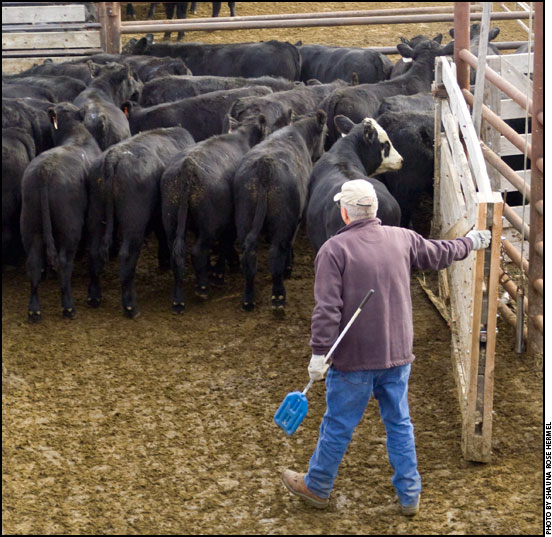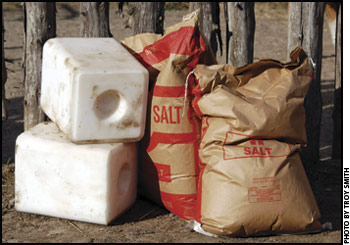HEALTH & NUTRITION...

Healthy Cattle, Healthy Profits
Treating cattle for sickness in the feeding phase may be costing more than you thought, emphasizing the need to keep cattle healthy from Day 1.
"Of course, healthy cattle have lower treatment costs," says Gary Fike, beef cattle specialist for Certified Angus Beef LLC (CAB). "But they also perform much better in the yard and on the rail. That combination sets up the huge gaps between who makes money feeding cattle and who doesn't." To be exact, those factors lead to a $190 net difference between cattle treated twice and those that never needed treatment (see Table 1).
| Table 1: Effect of health treatments on feedlot performance, carcass traits and profitability | |||
Item |
Number of times treated |
||
NT |
1T |
2T |
|
| Arrival wt., lb. | 650 | 617 | 601 |
| Delivery age, days | 302.8 | 274.1 | 263.9 |
| Final adj. wt., lb. | 1,183 | 1,155 | 1,133 |
| ADG, lb./day | 3.22 | 3.06 | 2.93 |
| Days on feed | 167.0 | 177.9 | 183.7 |
| HCW, lb. | 727.3 | 709.9 | 698.9 |
| Rib fat, in. | 0.45 | 0.43 | 0.39 |
| Marbling score | 429.4 | 413.8 | 395.9 |
| % CAB | 18.71 | 14.36 | 11.19 |
| Treatment cost, $/hd. | 0.00 | 24.04 |
61.41 |
| Cost of gain, $/cwt/ | 61.82 |
69.09 |
73.18 |
| Profit, U.S.$/hd. | $52.45 | ($15.16) |
($137.30) |
Fike shed light on the effect of health treatments on feedlot performance, carcass traits and profitability at the Midwest section meetings of the American Society of Animal Science (ASAS) mid-March (see Table 1). The information was drawn from Iowa Tri-County Steer Carcass Futurity (TCSCF) data on nearly 50,000 head of cattle fed in 18 Iowa feedlots since 2002.
Cattle that remained healthy during the feeding phase had heavier delivery weights, final weights, stronger gains and fewer days on feed than their treated counterparts. Cattle that were never treated in the feedlot arrived weighing 650 pounds (lb.); those that ended up being treated once weighed 617 lb. and those treated twice entered the yard at 601 lb.
"There's a lesson in those numbers," Fike points out. "The cattle that were not treated are a little older and heavier when they arrive, which tells me they spent more time at home being backgrounded and getting all those sickness problems straightened out before they ever left the ranch."
The percentage of carcasses that met Certified Angus Beef® (CAB®) brand acceptance dropped from 19% of cattle never treated to 11% of those treated twice.
"Those healthy cattle lay on intramuscular fat more easily thanks to that added gain," Fike says.
Lung Lesions Deflate Profits
Darrell Busby, TCSCF manager, presented related research at the Midwest ASAS meetings. That study focused on the cost of lung adhesions, which data revealed amounts to more than $40 per head (see Table 2). Busby says that cost is the result of the same issues uncovered in the study of health treatment costs.
| Table 2: Effect of lung adhesions on feedlot performance, carcass traits and profitability | ||
Item |
Lung adhesion |
|
NT |
1T |
|
| Arrival wt., lb. | 643 | 635 |
| Final adj. wt., lb. | 1,176 | 1,160 |
| ADG, lb./day | 3.19 | 3.01 |
| Days on feed | 169 | 176 |
| HCW, lb. | 725 | 703 |
| Rib fat, in. | 0.44 | 0.43 |
| Marbling score | 426.6 | 410.0 |
| % CAB | 18.12 | 12.46 |
| Treatment cost, $/hd. | 5.29 | 12.23
|
| Cost of gain, $/cwt/ | 63.18 |
67.27
|
| Profit, U.S.$/hd. | $45.27 | $1.65
|
"The cattle with lung adhesions weigh 8 lb. less than those with none," he says. "That indicates there are a lot of things that happen prior to the feedlot that cause these lung adhesions."
In the study, lung adhesions were defined as blemishes that require a knife to remove the lung tissue from the ribcage of the carcass.
"Our data is recognizing that these severe cases of lung adhesions, which represent about 4% of the population, are what cause the most damage in terms of lost performance, lighter carcass weights and lower marbling scores," Busby says.
Cattle with lung adhesions had to be administered health treatments 2.2 times more than those without. Similar to the data Gary Fike presented (see "Healthy Calves, Healthy Profits"), Busby says that hike in treatment cost (nearly $7 more for individual drug treatments) isn't the only place cattle with lung adhesions lose. The percentage of carcasses that met Certified Angus Beef® (CAB®) brand acceptance dropped from 18% to 12% when lung adhesions were present.
Value Reduced After BVD-PI Exposure
Estimated economic losses caused by exposure to PI cattle could be between $40 and $90 per animal due to increased mortality and morbidity, decreased performance.
Fever, pneumonia, diarrhea and compromised immunity are among the telltale signs of infection with the group of viruses that cause bovine viral diarrhea, an economically significant disease that affects cattle herds throughout the world. Calves exposed to bovine viral diarrhea virus (BVDV) in utero may develop persistent infections and shed the virus throughout their lives. Post-birth exposure to BVDV usually leads to acute infections that last seven to 10 days.
With lifelong compromised health, persistently infected (PI) cattle are obviously a drain on economic resources, but they may be even more costly than previously assumed. A collaborative study involving scientists from the Agricultural Research Service (ARS) shows that PI cattle can actually decrease the profitability of surrounding cattle — even those that never develop clinical disease. Read more.
New Leads in Transmission of Vesicular Stomatitis
Research shows grasshoppers can pass the virus to cattle, but a common grasshopper pesticide kills the virus on plants.
Vesicular stomatitis virus (VSV) is endemic in Mexico and causes sporadic outbreaks in the United States. Though rarely fatal, VSV causes physical discomfort in livestock, reduces production efficiency and may result in serious secondary infections. Because clinical signs in cattle and pigs are similar to those of foot-and-mouth disease (FMD), every outbreak must be closely monitored. New research from ARS scientists in Wyoming could help prevent the spread of VSV. Read more.
Keep Cattle Cool and Stress-Free
Identifying the causes of heat stress in cattle and finding ways to manage it are the goals of ARS scientists and cooperators who are helping producers deal with this significant production problem.
Heat stress can have serious consequences. While some cattle exhibit little or no response to it, others may experience diminished appetite and feed intake, reduced growth rate, compromised disease resistance and, in extreme cases, death.
Extremely high temperatures overwhelm an animal's natural ability to regulate its body temperature. But other factors are involved, and understanding them is essential for predicting, preventing and responding to potential heat-stress scenarios, according to scientists at the ARS Roman L. Hruska U.S. Meat Animal Research Center (USMARC) in Clay Center, Neb.
There, scientists are working together with cooperators to develop risk-assessment tools and management strategies for producers. This work has three main components: analyzing animal susceptibility, identifying contributing environmental factors, and evaluating management techniques.
In one study, USMARC agricultural engineer Tami Brown-Brandl and colleagues conducted several studies to identify factors that contribute to animal susceptibility to heat stress. They identified 11 influential factors, including coat color, health history and temperament.
In another study, Brown-Brandl and USMARC agricultural engineers Roger Eigenberg and John Nienaber looked at environmental factors affecting the intensity of heat stress. They developed a model that incorporates predictions of how temperature, humidity, sun intensity and wind speed will affect heat stress. The model is available online at www.ars.usda.gov/Main/docs.htm?docid=17130.
Read more about this research in the March 2010 issue of Agricultural Research magazine, available online at www.ars.usda.gov/is/AR/archive/mar10/cattle0310.htm.
Don't Forget the Salt
You may never have heard about cattle dying due to salt deprivation, but it could happen. Cattle need salt. They know it, too, and they appear to like its flavor. When their diet is deficient in salt, cattle will seek it by sampling things they wouldn't normally eat — even dirt.
"Plain old sodium chloride (NaCl) is important stuff," says North Dakota State University Extension Veterinarian Charles Stoltenow. "Both ions are important to many body functions, but especially sodium. It's necessary to nerve impulse conduction signaling muscle contraction. It plays a role in maintaining osmotic balance in every cell in the body."
 Cattle on range or pasture naturally consume a low-sodium diet, since most forage species are low in sodium. Animals whose diets are deficient in salt will not perform up to their genetic potential for growth, fertility, reproduction or milk production. In fact, cattle require salt in relatively large amounts, compared to other minerals. So, it's particularly important to provide free-choice supplemental salt to cattle on pasture.
Cattle on range or pasture naturally consume a low-sodium diet, since most forage species are low in sodium. Animals whose diets are deficient in salt will not perform up to their genetic potential for growth, fertility, reproduction or milk production. In fact, cattle require salt in relatively large amounts, compared to other minerals. So, it's particularly important to provide free-choice supplemental salt to cattle on pasture.
"Consumption of salt can vary considerably, depending on the forages available. But consumption probably averages around 3 to 4 ounces per day," Stoltenow says.
"Because cattle crave it (but typically will not overconsume), salt makes a good carrier for other mineral supplements," he says. Producers are advised to find appropriate commercial mineral mixes containing calcium, phosphorus and trace minerals, or have one custom-formulated to meet needs specific to their location. The mineral can then be mixed with salt to manage intake of the mineral mix.
If cattle seldom eat more salt than they can handle, why is salt toxicity sometimes a concern? Stoltenow says it's not a matter of consuming too much salt. Rather, it's a problem of when water consumption is limited or nonexistent, and the animal's sodium-regulating systems become ineffective. Excessive sodium levels can lead to death.
If cattle are deprived of water for a period of time, Stoltenow warns against allowing them to drink too much too quickly. Drinking their fill can make matters worse by causing swelling of the brain.
"There's an important balance to be maintained between salt and water, so producers need to make sure there is no interruption of the cattle water supply," Stoltenow explains. "And keep salt in front of them, too."
Strategic Deworming
Test herd, then treat to avoid parasite resistance.
As instances of internal parasite resistance to deworming treatments are becoming more numerous among the country's cattle herds, it becomes apparent that herd managers must pay closer attention to the use of these valuable herd health tools. Controlling parasites is a proven practice to improve performance in all stages of cattle production; however, both overuse and underuse of anthelmintics can lead to a resistance problem. Read more.
Cattle Diseases: Common Conditions/Terms
Click here for a list of common conditions and terms related to beef cattle diseases, such as anaplasmosis, brucellosis, BVD, E. coli, IBR and others.
[Click here to go to the top of the page.]





